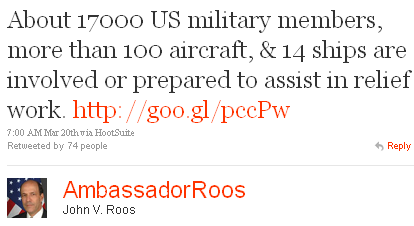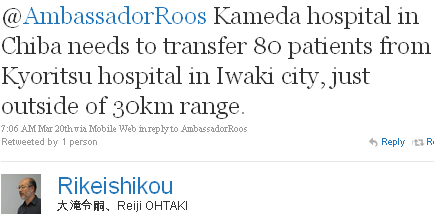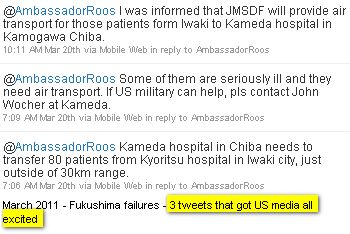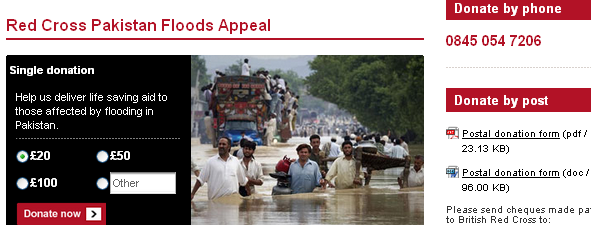2012-06-07 UPDATE: Why Twitter chat does not help in crisis situations – raising funds, etc.
Christchurch, New Zealand was shaken by an earthquake on February 22, 2011 and less than three weeks later, a 9.0 Richter tremor struck Japan on 2011-03-11 at 05:46 hours UTC (14:46 hours local time), also precipitating a nuclear disaster and radiation leak at Fukushima.
If we are to believe a reporter for USA Today, Twitter once again came to the rescue in Japan.
- Article source:
Twitter in a crisis: 6 tips for a faster rescue
But hang on, does social media really make a difference to those affected by a disaster? Before we can benchmark we need to clarify some issues.
1. Twitter is great – if the infrastructure works
The disaster has underlined shortage of domestic energy sources. Before the quake, nuclear power provided 30 percent of electricity supplies in Japan, with plans to increase that to 50 percent by 2030. Harrowing scenes from the crippled site have provoked widespread re-examination of nuclear safety, around the world and in Japan.
Since only a relatively small part of the country was affected by the tsunami however, much of the telecommunication infrastructure beyond a ten-kilometer radius still worked. But Pakistan’s floods earlier in the year proved that without necessary infrastructure, most people have no chance to access the Internet.
And while generators were used to recharge mobiles in Haiti, a flood more than a meter high, such as in Pakistan, would likely flood all generators, making them useless.
Get the latest post first, subscribe yourself by leaving your email address right here:
2. One happy camper does not a happy nation make
 Japan’s situation has been used to tout the greatness of social media for victim assistance, as in the case of Kyoritsu Hospital, about 40 km from the Fukushima nuclear power plant, with 80 patients requiring evacuation. Director Nobuo Hiwatashi issued an appeal through the Mainichi Japan newspaper that got no response.
Japan’s situation has been used to tout the greatness of social media for victim assistance, as in the case of Kyoritsu Hospital, about 40 km from the Fukushima nuclear power plant, with 80 patients requiring evacuation. Director Nobuo Hiwatashi issued an appeal through the Mainichi Japan newspaper that got no response.
 Then Amassador John Roos tweeted about US troops standing by to help, prompting citizen Reiji Ohtaki (@Rikeishikou) to reply. Roos alerted his defense attaché, who passed it up the military chain of command.
Then Amassador John Roos tweeted about US troops standing by to help, prompting citizen Reiji Ohtaki (@Rikeishikou) to reply. Roos alerted his defense attaché, who passed it up the military chain of command.
Eventually, Ohtaki tweeted that Japan’s Ground Self-Defense Forces would be getting the patients out (see latest tweets below). He just started using Twitter and continues to post infrequently to this day; his following is small, but the tsunami and nuclear disaster have led to an explosion of Twitter use in Japan.
 But what this case really reveals is that it is difficult for people to be heard in a crisis, period. Moreover, finding the appropriate party to direct the message to remains a challenge with or without social media.
But what this case really reveals is that it is difficult for people to be heard in a crisis, period. Moreover, finding the appropriate party to direct the message to remains a challenge with or without social media.
Kyoritsu Hospital apparently did not know whom to contact from the Japanese government to get a swift response – a disaster in itself – suggesting that crisis management may not be up to par.
Twitter may help those in need reach the right party in one or two cases. In this case, social media offered a last ditch effort by openly broadcasting the hospital’s cry for help, which also puts pressure on the party asked to take action.
Bottom line
As a social media afficionado, I am sure you will appreciate the following checklist to help prepare you for any type of disaster in your neck of the woods:
- 1. Ensure you have
mobile Internet access to networks through two providers
- in case one infrastructure fails.
- 2. To be ready for the worst, also
subscribe to a satellite service to assure uninterrupted internet access
- .
- 3. Store a
diesel generator a handy two meters above ground with a structure to protect it
- against earthquakes or tsunami, to enable gadget recharging in case the electricity grid fails (see Pakistan, Haiti, etc.).
- 4. Share important news by using @username for Twitter and less than 120 characters, making it easy for your followers to type RT @username while staying under the 140-character limit. This will increase your visibility and put pressure on those in a position to take action (i.e.
those that scream the loudest get help the quickest
- ).
- 5. If you are an important person like
- , ensure your assistants
monitor social media channels so you do not miss an important post
- .
- 6. Follow the example of the The International Atomic Energy Agency by posting
- to your channel to reach your audience
- .
If we are to believe some social media mavens, all it takes is staying connected to get rescued. Of course, this checklist is rather tongue-in-cheek. When disaster strikes, I know the last thing I worry about is updating my Facebook wall or using my smartphone to provide a status update via a micro-blogging service like Twitter or Identi.ca.
Tip: Click here to find more content on ComMetrics about disaster management, relief management and human rights.
In the meantime, have you donated to the Pakistan or Japan relief efforts, and the people in Libya fighting for their human rights?
What is your take? Do you feel social media really makes a difference for those on the ground? Have you been in a crisis or emergency situation and used Twitter to get rescued?

Pingback: Ruhani Rabin
Pingback: Yuniono Budi Santoso
Pingback: Ruhani Rabin
Pingback: Ruhani Rabin
Pingback: CouponSavings
Pingback: Fenno Ugri
Pingback: Go! Social Media
Pingback: David L.A
Pingback: Ruhani Rabin
Pingback: Ruhani Rabin
Pingback: RK
Pingback: Jeff Oliver
Pingback: Ruhani Rabin
Pingback: Ruhani Rabin
Pingback: Ruhani Rabin
Pingback: Sarah-Jayne Gratton
Pingback: chrow
Pingback: Ruhani Rabin
Pingback: Ruhani Rabin
Pingback: Sólo dime Janos
Pingback: Ruhani Rabin
Pingback: Ruhani Rabin
Pingback: rebeca de paz lozano
Pingback: PlanB Consulting
Pingback: PlanB Consulting
Pingback: PlanB Consulting
Pingback: C Maclean-Bristol
Pingback: Ruhani Rabin
Pingback: Melanin Majority
Pingback: Ruhani Rabin
Pingback: Miguel Mendoza
Pingback: Rosemary
Pingback: Ruhani Rabin
Pingback: Ruhani Rabin
Pingback: Ruhani Rabin
Pingback: Belinda Ang
Pingback: Mehul V. Pithadia
Pingback: Ruhani Rabin
Pingback: Ruhani Rabin
Pingback: Urs E. Gattiker
Pingback: MyComMetrics
Pingback: Ruhani Rabin
Pingback: gail simmons